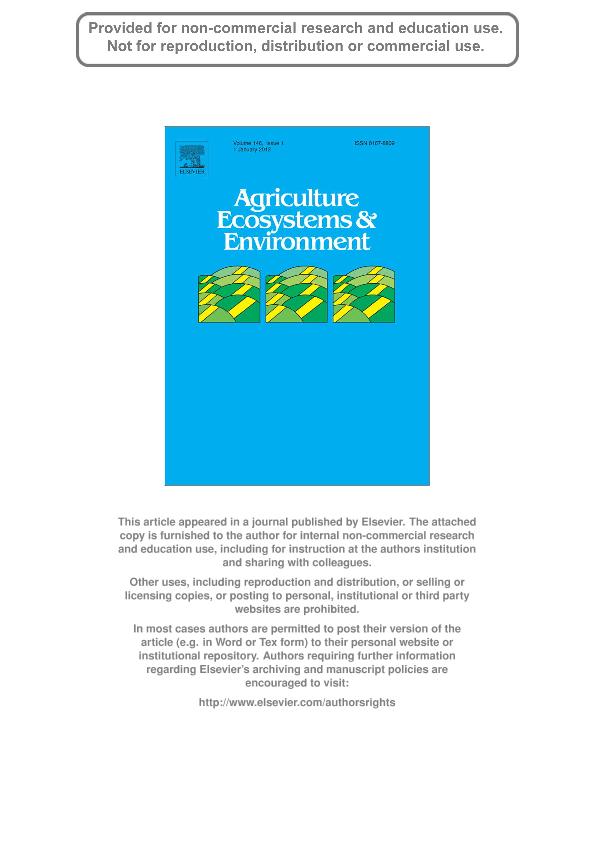Mostrar el registro sencillo del ítem
dc.contributor.author
Macchi, Leandro

dc.contributor.author
Grau, Ricardo Jose Antonio

dc.contributor.author
Zelaya, Patricia Viviana

dc.contributor.author
Marinaro Fuentes, María Sofía

dc.date.available
2016-08-16T15:34:59Z
dc.date.issued
2013-07
dc.identifier.citation
Macchi, Leandro; Grau, Ricardo Jose Antonio; Zelaya, Patricia Viviana; Marinaro Fuentes, María Sofía; Trade-offs between land use intensity and avian biodiversity in the dry Chaco of Argentina: A tale of two gradients; Elsevier; Agriculture, Ecosystems And Environment; 174; 7-2013; 11-20
dc.identifier.issn
0167-8809
dc.identifier.uri
http://hdl.handle.net/11336/7167
dc.description.abstract
Studies to assess the relationship between agriculture production and biodiversity conservation usually focus on one gradient ranging from a natural reference land cover type (typically forest) to an intensive productive land use. However, many semi-arid ecoregions such as the dry Chaco are characterized by a mosaic of different land covers, including natural grasslands and woody vegetation with different degrees of transformation, frequently aimed at meat production. We analyzed the associations between avian biodiversity and meat productivity of forest, natural grasslands, three types of livestock production systems, and soybean crops in northern Argentina dry Chaco; an area of c. 19 million ha characterized by high conservation value and rapid land use change. A Generalized Lineal Model analysis of reports and publications quantified a meat productivity range in which soybean (the less diverse land cover type) doubles the most efficient livestock systems, and is eight times more productive than the widespread puestos system. A multidimensional scaling ordination identified two independent gradients of bird's response to increasing land use intensity, respectively from protected forests and from natural grasslands, to highly transformed systems. Along both gradients avian richness and density sharply declined in the transition from semi-natural land covers to planted pastures and similarity to native grasslands and protected forests decreased exponentially. Along the “grasslands gradient”, bird richness and density presented a unimodal response. Maximum likelihood-fitted curves of bird's guilds response to the productivity gradients showed that in the “forest gradient” most guilds decreased exponentially or linearly, whereas in the “grasslands gradient” most guilds peaked at intermediate levels of meat yield. Our results suggest that land sparing strategies can be more efficient to balance agriculture production with the conservation of forest avian diversity, but also that the prevailing “forest oriented” conservation schemes (e.g. Argentine Forest Law) do not capture the complexity of the system and both forests and grassland gradients should be considered in land use planning, possibly including a combination of conservation strategies.
dc.format
application/pdf
dc.language.iso
eng
dc.publisher
Elsevier

dc.rights
info:eu-repo/semantics/openAccess
dc.rights.uri
https://creativecommons.org/licenses/by-nc-nd/2.5/ar/
dc.subject
Land Use Changes
dc.subject
Dry Chaco
dc.subject
Trade Off
dc.subject
Birds Conservation
dc.subject.classification
Ciencias Medioambientales

dc.subject.classification
Ciencias de la Tierra y relacionadas con el Medio Ambiente

dc.subject.classification
CIENCIAS NATURALES Y EXACTAS

dc.title
Trade-offs between land use intensity and avian biodiversity in the dry Chaco of Argentina: A tale of two gradients
dc.type
info:eu-repo/semantics/article
dc.type
info:ar-repo/semantics/artículo
dc.type
info:eu-repo/semantics/publishedVersion
dc.date.updated
2016-08-11T19:37:15Z
dc.journal.volume
174
dc.journal.pagination
11-20
dc.journal.pais
Países Bajos

dc.journal.ciudad
Amsterdam
dc.description.fil
Fil: Macchi, Leandro. Universidad Nacional de Tucumán. Facultad de Ciencias Naturales e Instituto Miguel Lillo. Instituto de Ecología Regional; Argentina. Consejo Nacional de Investigaciones Científicas y Técnicas. Centro Científico Tecnológico Tucumán; Argentina
dc.description.fil
Fil: Grau, Ricardo Jose Antonio. Universidad Nacional de Tucumán. Facultad de Ciencias Naturales e Instituto Miguel Lillo. Instituto de Ecología Regional; Argentina. Consejo Nacional de Investigaciones Científicas y Técnicas. Centro Científico Tecnológico Tucumán; Argentina
dc.description.fil
Fil: Zelaya, Patricia Viviana. Universidad Nacional de Tucumán. Facultad de Ciencias Naturales e Instituto Miguel Lillo. Instituto de Ecología Regional; Argentina. Consejo Nacional de Investigaciones Científicas y Técnicas. Centro Científico Tecnológico Tucumán; Argentina
dc.description.fil
Fil: Marinaro Fuentes, María Sofía. Universidad Nacional de Tucumán. Facultad de Ciencias Naturales e Instituto Miguel Lillo. Instituto de Ecología Regional; Argentina. Consejo Nacional de Investigaciones Científicas y Técnicas. Centro Científico Tecnológico Tucumán; Argentina
dc.journal.title
Agriculture, Ecosystems And Environment

dc.relation.alternativeid
info:eu-repo/semantics/altIdentifier/urn/http://www.sciencedirect.com/science/article/pii/S0167880913001217
dc.relation.alternativeid
info:eu-repo/semantics/altIdentifier/doi/10.1016/j.agee.2013.04.011
dc.relation.alternativeid
info:eu-repo/semantics/altIdentifier/doi/http://dx.doi.org/10.1016/j.agee.2013.04.011
Archivos asociados
